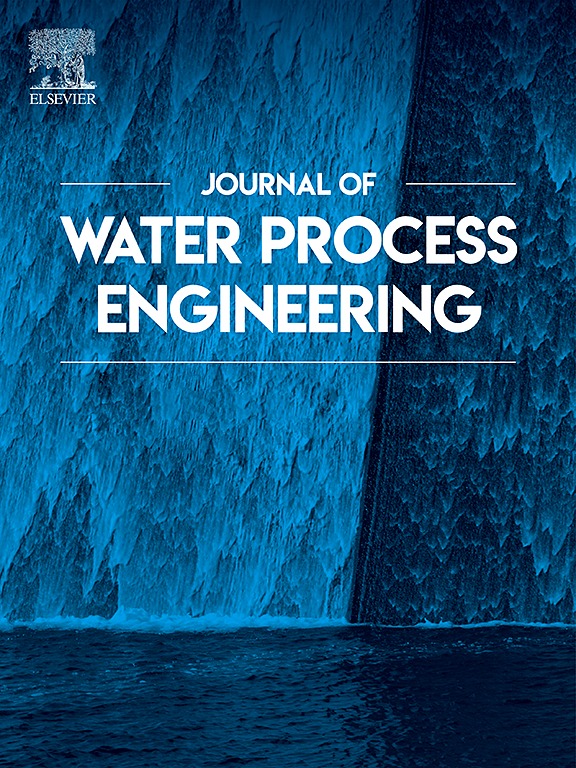Sustainable water treatment: Synthesis and characterization of g-C3N5/NiCo2S4 heterojunction nanocomposite for efficient visible light-induced degradation of highly hazardous organic pollutants
IF 6.3
2区 工程技术
Q1 ENGINEERING, CHEMICAL
引用次数: 0
Abstract
Recent modernization has fostered economic growth and altered lifestyles, but has also increased environmental pollution, particularly water contamination. In addressing this challenge, photocatalysis utilizing various photocatalysts, particularly graphitic carbon nitride (g-C₃N₄), has gained significant attention. Building on the success of g-C₃N₄, g-C₃N₅ has emerged as a promising photocatalyst with enhanced properties. In this study, a g-C₃N₅/NiCo₂S₄ nanocomposite was synthesized by varying the concentrations of g-C₃N₅ and NiCo₂S₄. The structural characteristics and their variations were analysed using XRD and FT-IR analyses. The chemical coordination and optical properties were investigated by XPS and UV–Vis spectroscopy, respectively. Pristine g-C₃N₅ exhibits an agglomerated sheet-like structure, whereas NiCo₂S₄ has a bulk, plate-like morphology. In the nanocomposites, the NiCo₂S₄ plate-like structures are uniformly distributed on the surface of g-C₃N₅ sheets, as observed in SEM and HR-TEM, and EDAX analysis confirms the presence of all elements in the composite. The photocatalytic degradation efficiency of the nanocomposites was evaluated using Brilliant Green (BG) dye and Congo Red (CR) dye under visible light irradiation and the results were compared with pristine materials. The degradation efficiency improved with increasing g-C₃N₅ loading, achieving 94.37 % degradation of BG dye within 100 min and 88.83 % degradation of CR dye within 180 min. The nanocomposite showed excellent stability over five cycles, making it a viable and cost-effective candidate with good efficiency. Thus, this nanocomposite holds significant promise for the sustainable degradation of toxic organic pollutants, offering a potential solution in future wastewater treatment.

可持续水处理:用于可见光诱导高效降解高浓度有机污染物的g-C3N5/NiCo2S4异质结纳米复合材料的合成和表征
最近的现代化促进了经济增长和生活方式的改变,但也增加了环境污染,特别是水污染。为了解决这一挑战,利用各种光催化剂的光催化,特别是石墨化碳氮化碳(g-C₃N₄),已经得到了极大的关注。在g-C₃N₄成功的基础上,g-C₃N₅已成为一种具有增强性能的有前途的光催化剂。在本研究中,通过改变g-C₃N₅和NiCo₂S₄的浓度,合成了g-C₃N₅/NiCo₂S₄纳米复合材料。采用XRD和FT-IR分析了其结构特征及其变化规律。用XPS和UV-Vis光谱分别研究了其化学配位和光学性质。原始的g-C₃N₅呈现出凝聚的片状结构,而NiCo₂S₄具有块状的片状形态。在纳米复合材料中,NiCo₂S₄片状结构均匀分布在g-C₃N₅片材表面,如在SEM和HR-TEM中观察到的那样,EDAX分析证实了复合材料中所有元素的存在。采用亮绿(BG)染料和刚果红(CR)染料对纳米复合材料在可见光下的光催化降解效率进行了评价,并与原始材料进行了比较。随着g-C₃N₅负载的增加,降解效率提高,在100 min内对BG染料的降解率为94.37%,在180 min内对CR染料的降解率为88.83%。该纳米复合材料在5次循环中表现出优异的稳定性,使其成为具有良好效率的可行且经济高效的候选材料。因此,这种纳米复合材料对有毒有机污染物的可持续降解具有重要的前景,为未来的废水处理提供了潜在的解决方案。
本文章由计算机程序翻译,如有差异,请以英文原文为准。
求助全文
约1分钟内获得全文
求助全文
来源期刊

Journal of water process engineering
Biochemistry, Genetics and Molecular Biology-Biotechnology
CiteScore
10.70
自引率
8.60%
发文量
846
审稿时长
24 days
期刊介绍:
The Journal of Water Process Engineering aims to publish refereed, high-quality research papers with significant novelty and impact in all areas of the engineering of water and wastewater processing . Papers on advanced and novel treatment processes and technologies are particularly welcome. The Journal considers papers in areas such as nanotechnology and biotechnology applications in water, novel oxidation and separation processes, membrane processes (except those for desalination) , catalytic processes for the removal of water contaminants, sustainable processes, water reuse and recycling, water use and wastewater minimization, integrated/hybrid technology, process modeling of water treatment and novel treatment processes. Submissions on the subject of adsorbents, including standard measurements of adsorption kinetics and equilibrium will only be considered if there is a genuine case for novelty and contribution, for example highly novel, sustainable adsorbents and their use: papers on activated carbon-type materials derived from natural matter, or surfactant-modified clays and related minerals, would not fulfil this criterion. The Journal particularly welcomes contributions involving environmentally, economically and socially sustainable technology for water treatment, including those which are energy-efficient, with minimal or no chemical consumption, and capable of water recycling and reuse that minimizes the direct disposal of wastewater to the aquatic environment. Papers that describe novel ideas for solving issues related to water quality and availability are also welcome, as are those that show the transfer of techniques from other disciplines. The Journal will consider papers dealing with processes for various water matrices including drinking water (except desalination), domestic, urban and industrial wastewaters, in addition to their residues. It is expected that the journal will be of particular relevance to chemical and process engineers working in the field. The Journal welcomes Full Text papers, Short Communications, State-of-the-Art Reviews and Letters to Editors and Case Studies
 求助内容:
求助内容: 应助结果提醒方式:
应助结果提醒方式:


